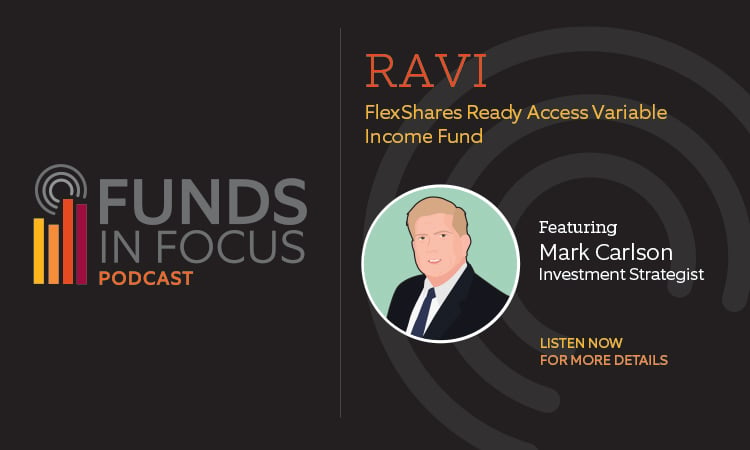Today’s interest rate environment has many investors feeling like they’re sitting through a remake of a bad Hollywood movie. After the Fed’s response to the 2008 Great Financial Crisis (GFC) marked the beginning of a prolonged period of zero interest rate policy (ZIRP), we again find ourselves in a ZIRP environment in response to the COVID-19 crisis.
On a recent episode of our Funds in Focus podcast, Senior Investment Strategist Mark Carlson discusses how this unwelcome movie remake unfolded—and introduces the concept of “investing liquidity” for a low yield environment.
In this episode, you'll learn
- What is different this time with ZIRP 2020
- What happened in 2020 to disrupt the sector
- What FlexShares has done in an effort to try and address the issues within fixed income strategy to help investors through these challenging periods of managing short-term liquidity assets
- How you may want to consider utilizing the investment strategy behind RAVI in today’s volatile and uncertain markets
THE ORIGINAL AND THE REMAKE
As the GFC roiled markets in 2008, the Fed responded with multiple rounds of quantitative easing (QE)—consisting of asset purchases through 2014—and held the overnight interest rate at virtually zero from December 2008 to December 2015. This effectively amounted to a prolonged, seven-year period of ZIRP.
Fast forward to 2020, when the COVID-19 crisis sent shockwaves through global markets and economies. As the pandemic crisis resulted in an unprecedented collapse of global demand and supply chain disruptions, the Fed once again implemented QE purchases and lowered rates back to ZIRP territory.
Of course, no movie remake is a carbon copy of the original, and this is certainly the case when comparing today’s ZIRP environment with 2008. For one, unlike in 2008, interest rates going into the current crisis were already at low levels. And the root of each crisis differs materially in nature. The financial institutions that largely contributed to the GFC are in fairly good shape today—it’s the nonfinancial businesses that require assistance because of COVID-related shutdowns.
Another key difference is how the two ZIRP environments are impacting money market fund investing. The GFC revealed some cracks in the money market fund industry, and the SEC subsequently revised rules governing the funds in an effort to prevent another crisis in the sector. In the current ZIRP environment, these new SEC rules are impacting investors’ management of their short-term liquidity portfolios.
A CHANGED MONEY MARKET FUND WORLD
In an effort to address lessons learned from the GFC, the SEC passed new rules in 2014 to improve the liquidity and credit quality of retail and institutional money market funds. The rules introduced liquidity requirements and measures aimed at reducing credit risk and maturity restrictions—all with the objective of protecting remaining investors in the event of large withdrawals.
However, with these added protections came tradeoffs. Prior to the GFC, investors could potentially receive overnight liquidity, a stable dollar NAV, and a competitive return from money market funds. While the new SEC rules offer greater protection of asset value and overnight liquidity, these protections can come at the expense of higher income.
INTRODUCING “INVESTING LIQUIDITY”
At FlexShares, we believe these rules mean investors will increasingly have to choose between capital preservation and the potential for higher income. And in today’s ZIRP environment, investors who can tolerate some level of price volatility might look to their liquidity holdings as a potential source of income.
We describe this concept of prioritizing income over capital preservation in liquidity holdings as “investing liquidity.” This concept was behind the development of our FlexShares Ready Access Variable Income Fund (RAVI), which is an ETF designed to offer investors a short-term vehicle with strong return potential while maintaining liquidity. And with the current ZIRP environment and uncertainty around the future direction of global markets, RAVI can be a solution for investors seeking current income consistent with the preservation of capital and liquidity.
Please note the Fund is subject to certain risks, including the principal risks noted below, any of which may adversely affect the Fund's net asset value ("NAV").
IMPORTANT INFORMATION
FlexShares Ready Access Variable Income Fund (RAVI) is actively managed and does not seek to replicate a specified index. Additionally, the Fund may invest without limitation in the fixed income and debt securities of foreign issuers in both developed and emerging markets. The Fund is at increased credit and default risk, where there is an inability or unwillingness by the issuer of a fixed income security to meet its financial obligations, debt extension risk, where an issuer may exercise its right to pay principal on an obligation later than expected, as well as interest rate/maturity risk, where the value of the Fund's fixed income assets will decline because of rising interest rates. The Fund may also be subject to increased concentration risk as it may invest more than 25% of its assets into the securities of a single developed market. Additionally, the Fund may invest without limitation in mortgage or asset-backed securities, which puts it at increased risk for interest rate/maturity risk, debt extension risk, and prepayment (or call) risk. Also, the Fund is "non-diversified" under the Investment Company Act of 1940, and may invest more of its assets in fewer issuers than diversified funds.

